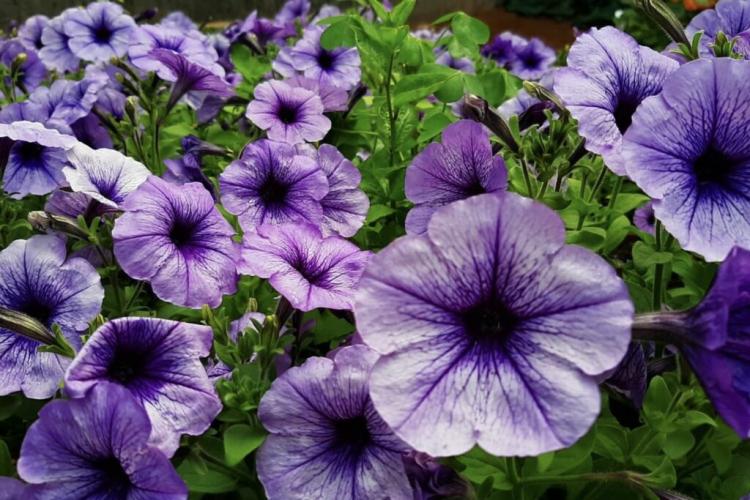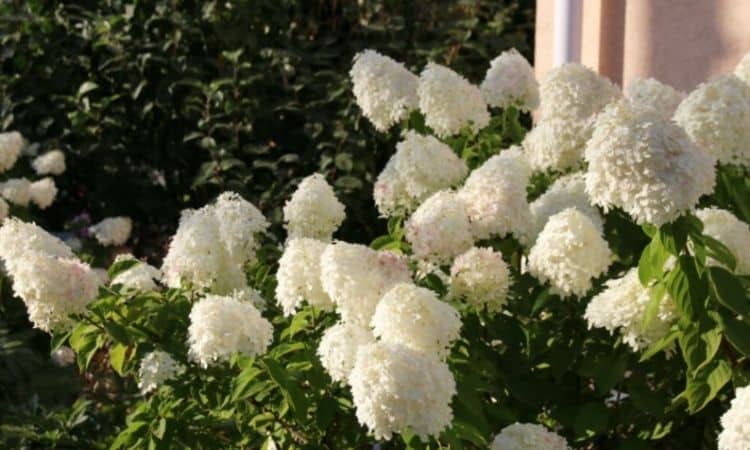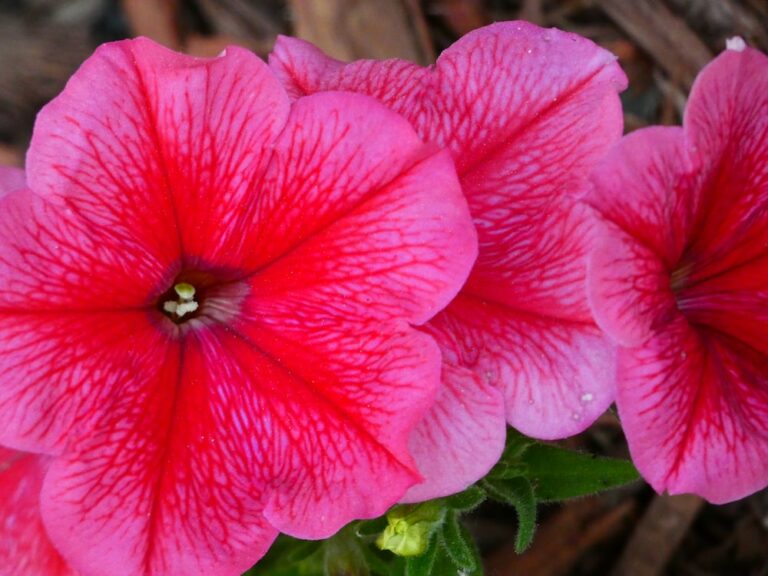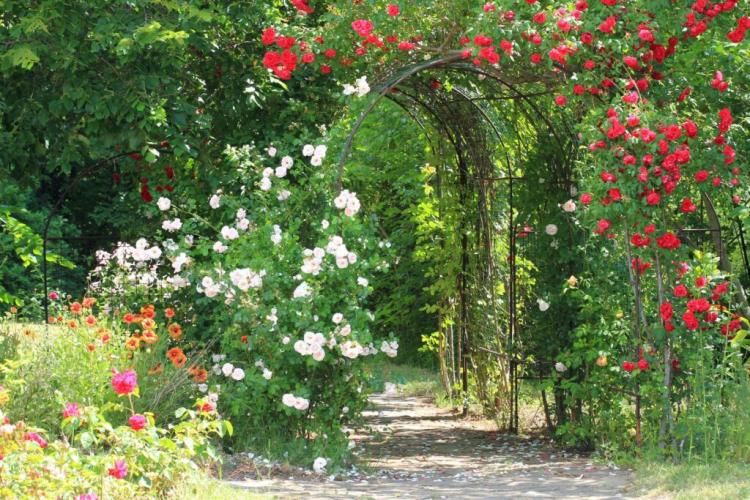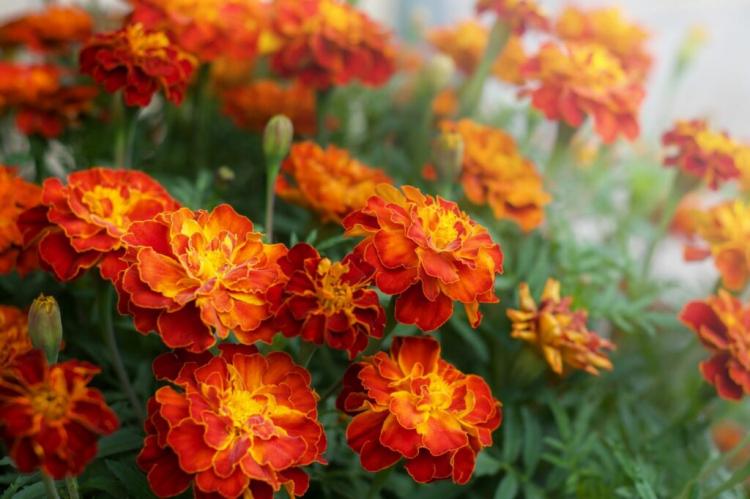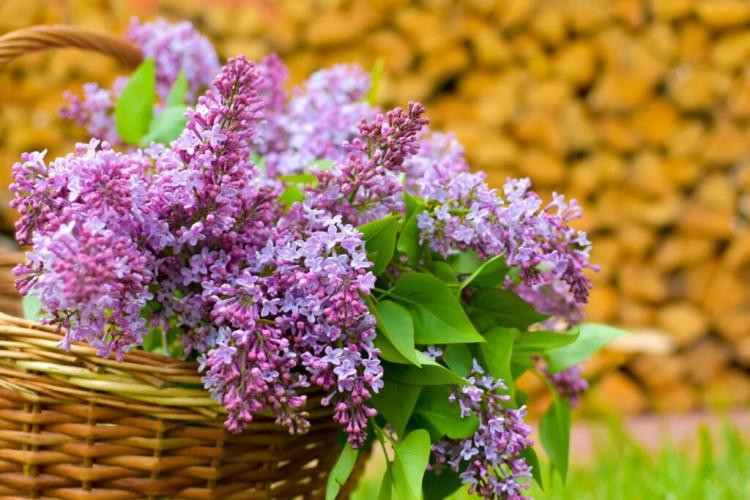Climbing hydrangea: our tips for planting, caring for and propagating
Everything about the climbing hydrangea: from planting to propagation and different varieties. With expert advice on the toxicity and care of the climbing hydrangea.
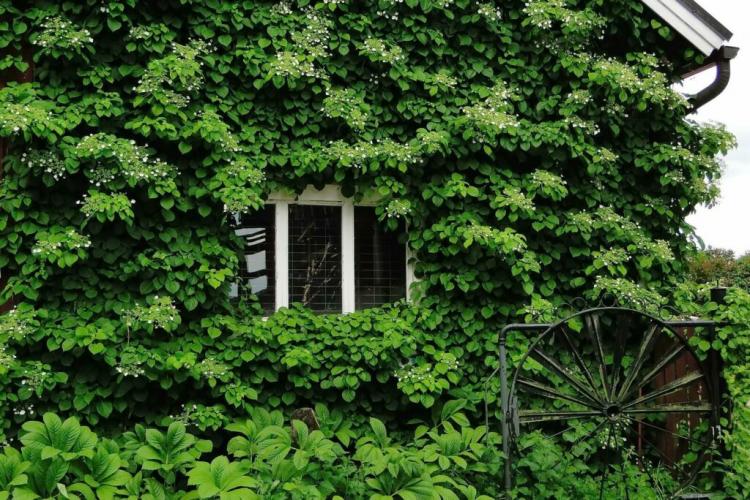
The climbing plant turns facades into green eye-catchers [Photo: SariMe / Shutterstock.com]
Climbing hydrangeas ( Hydrangea anomala sbsp . Petiolaris ) are enjoying increasing popularity. This is no wonder, because the self-climber is not only easy to care for, but also tolerates forest, shady places and provides a flowering decoration in a variety of ways – for example as a greening of facades, as a colorful privacy screen or as a summer green bee pasture.
Climbing hydrangeas: characteristics and peculiarities
Table of Contents
The climbing hydrangea, like ivy ( Hedera helix ), is a so-called self-climber, which uses adhesive roots to keep itself on rough surfaces. This means that it can climb 10-15 meters in height without a climbing aid with adherent roots. The climbing beauty can not only grow upwards, but is extremely diverse in its growth. If, for example, there is no climbing option, it can also be cultivated to cover the ground, free-standing or around tree trunks.
The plant, which originally came from Taiwan, Korea and Japan, is now well established in our latitudes. The climbing hydrangea makes facades a real eye-catcher. However, you need a little patience, because the climbing plant does not start to flower for the first time until it has been standing for five to eight years. The inflorescences appear in the form of flat panicles up to 25 cm in size. These consist of small, hermaphroditic four to five-fold flowers and the marginal, sterile, approximately 3 cm large show flowers in white color. The flowers appear between June and July and, with their sweet scent, attract important insects such as bumblebees, bees and butterflies.

The sweet smelling flowers attract many insects [Photo: EQRoy / Shutterstock.com]
The climbing hydrangea not only takes time for the flowers, its growth is also slow for the time being. In the first few years it is less vigorous, but later it can grow up to one meter per year if the site conditions are good. The leaves of the deciduous ornamental plant are dark green, arranged opposite one another and have a rounded to egg-shaped shape. A special feature of the climbing hydrangea is that it tolerates both frost and shade. So it can be used perfectly in locations that are out of the question for many other plants.
Climbing hydrangea varieties
Currently, the selection of different types of climbing hydrangea is still very clear. Below are the main varieties currently on the market.
Varieties of climbing hydrangea:
- ‘Miranda’ : About 3 m high, cream-white flowering variety; green leaves framed in pastel yellow.
- ‘Cordifolia’ : dwarf shrub with heart-shaped leaves; smaller, slow growth up to 2 m in height.
- ‘Silver Lining’ : Growth up to 3 m in height, light green leaves with a white-silvery border, white flowers.
- ‘Semiola’ : new variety that keeps its leaves in mild winters; copper-red shoots and white flowers.
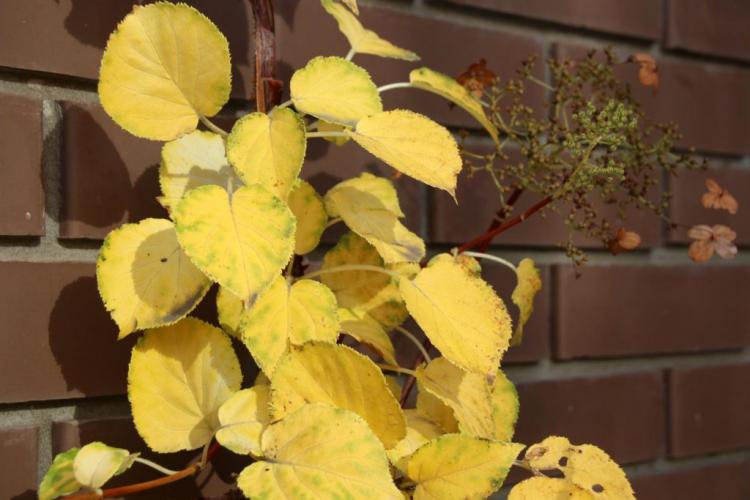
Many varieties have bright yellow leaves in autumn [Photo: photowind / Shutterstock.com]
Note on evergreen climbing hydrangeas : With most climbing hydrangeas, the leaves begin to turn bright yellow in autumn before they fall off. However, there are now also evergreen varieties. This includes, for example, the ‘Semiola’ variety mentioned above. This new breed retains its leaves in mild winters and is particularly beautiful to look at thanks to its copper-red shoot.
Planting climbing hydrangeas: location and procedure
When planting the climbing hydrangea, the most important thing is the location and the right procedure.
Where should climbing hydrangeas be planted?
As a forest plant, the climbing hydrangea prefers cool, moist soils and partially shaded locations. But even in deeper shade or in full sun, the plant can still show satisfactory growth with appropriate care. The climbing hydrangea prefers to take root in humus-rich, well-drained and moist soils that are not compacted and have an acidic to neutral pH value. Too sandy or too clayey soils should best be improved with humus potting soil like our Plantura organic acid soil. Their acidic pH value and the low proportion of peat are particularly beneficial for the lime-avoiding climbing hydrangea, because this way they experience an even supply of water and nutrients.
If possible, it is advisable to place the climbing hydrangea in a sheltered location.
Tip: Young climbing hydrangeas are sensitive to late frosts and too much sunlight. Leaf damage caused by “sunburn” is not uncommon.
Instructions: how to plant your climbing hydrangea
It is very likely that the climbing hydrangea will be in the pot in which it was pre-cultivated before planting out. When the contents of the pot are dry, it is a good idea to put them in a water bath for about 10 minutes before planting them out. In this way, the root ball can properly soak itself up with water in advance. You can then remove the plant from the pot and place it in the previously prepared planting hole.
Since the climbing hydrangea has broad roots near the surface, the planting hole can be shallow, but raised all the wider. Make sure that the soil below is permeable so that water can drain off well – the climbing hydrangea does not like waterlogging. Now it is also a good idea to enrich the excavated soil with acidic potting soil such as our Plantura organic acidic soil and hydrangea fertilizers. Thanks to its long-term effect, our Plantura organic hydrangea fertilizer provides all the important nutrients that the hydrangea needs to grow over many months. Only sustainable raw materials are used, not animal remains from meat production.
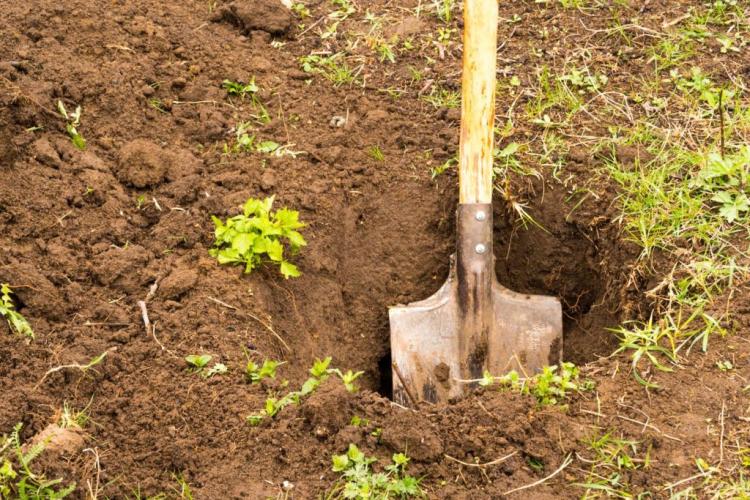
A planting hole must be dug before planting out [Photo: Lubsan / Shutterstock.com]
The plant is then planted with the excavated soil as deep as it was previously in the pot. Since climbing hydrangeas are able to form roots that are sprouting, the plants can also tolerate deeper planting without any problems. Then it is important to water the plant generously and to properly sludge the soil. It is better to check more often over the next few days and weeks whether the soil is still damp. To ensure that as little irrigation water as possible is lost, you can also build a watering ring around the plant.
If you plan to plant several climbing hydrangeas, a distance of at least 60 cm should be maintained between the plants or to other climbing plants. You can generally plant them all year round, but early spring is best.
Note on climbing aid : In principle, climbing hydrangeas can independently climb a wide variety of surfaces with the help of their adhesive roots. These should be rough and insensitive: wood including bark, stone and rough concrete are well suited. The climbing hydrangea, which can reach considerable weight with age, could lose its grip on surfaces that are too smooth or in a location exposed to the wind. In the case of plastered house walls, a climbing aid is advisable in order to protect the wall from the adhesive roots. The best way to do this is to place the climbing aid at a distance of 10 to 15 cm from the house wall.
At a glance: how are climbing hydrangeas planted?
- Best in early spring
- If it is dry, place the container in a water bath for 10 minutes
- Dig the planting hole rather wide and loosen it in the subsoil
- Enrich the excavated soil with acidic potting soil and hydrangea fertilizer
- Plant the hydrangea with excavated material
- Water thoroughly and silt up the soil
- Erect the casting ring if necessary
- Plant spacing: 60 cm
Climbing hydrangeas in the bucket
The climbing hydrangea is also suitable as a blooming privacy screen on the terrace or balcony – the plant only needs to be planted in a sufficiently large container. The rule here is: the bigger, the better. In addition, the vessel should have holes in the bottom so that excess water can drain off. This is important because the climbing hydrangea often has to be watered and does not tolerate waterlogging. A well-water-storing, acidic potting soil such as our Plantura Bio-Acid Soil is perfectly suited as a substrate. Unlike many other hydrangea soils, this one is peat-reduced and thus saves CO2 over its entire life cycle.
For good water drainage, it is also possible to lay a layer of coarse-grained material such as perlite at the bottom of the bucket. So that the plant can grow upwards, it should also be given a climbing aid. A trellis made of sturdy wood is suitable for this, for example.
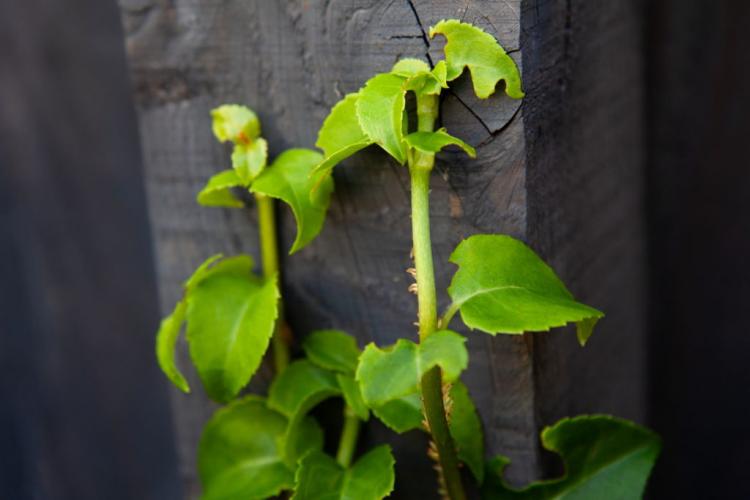
In order for the climbing hydrangea to grow and thrive, it needs the right care [Photo: Victoria Ashman / Shutterstock.com]
Tip: In the bucket, i.e. with a very limited volume of soil, regular fertilization is particularly important. In order to maintain the quality of the potting soil, you should rely on a primarily organic variant such as our Plantura organic hydrangea fertilizer – because the climbing hydrangea is reluctant to repot often.
Maintaining climbing hydrangeas
Climbing hydrangeas are robust and require little care. However, like all hydrangeas, they need adequate moisture and nutrients.
Water climbing hydrangeas
Climbing hydrangeas should not dry out, which is why you should water them additionally if there is no rainfall. The best way to check with a finger test is whether the substrate is already too dry. Climbing hydrangeas in particular can dry out quickly and should therefore be checked more often. When watering, it is advisable not to wet the leaves to prevent downy mildew.
Tip: To keep the soil moist longer, you can create a layer of mulch, for example made of leaves or bark, around your plant.
Cut climbing hydrangeas
In principle, climbing hydrangeas do not have to be cut, especially in the first few years. Due to their slow growth, it is sufficient to remove dead wood and dried up flowers. However, if the climber is out of shape or carries too much weight on one side, you may need to use scissors. If you want to do a normal maintenance cut, it is advisable to do this in autumn or winter. Since climbing hydrangeas bloom the most on annual and biennial wood, regular pruning can ensure richer flowering.
Find out the best way to go about pruning climbing hydrangeas here.
Fertilize climbing hydrangeas
Hydrangeas love rich soils. They need sufficient nutrients, especially for their lush flowers. For this it is advisable to work special hydrangea fertilizers into the soil between May and August. Our Plantura organic hydrangea fertilizer supports the climbing hydrangea with exactly the nutrient composition it needs: a lot of potassium, nitrogen as well as magnesium and iron. This allows the plant to develop strong leaves and flowers.
Propagate climbing hydrangeas
Another advantage of the climbing hydrangea is that it can be propagated very easily. The propagation can take place in early summer either via subsets or cuttings. You can obtain an offshoot by lowering a shoot that is already close to the ground towards the ground and fixing it in the ground. The shoot now forms sprout roots, so-called adventitious roots. For this method, it is important that the mother plant is well established, as it will provide the offshoot with water and nutrients in the transition phase.
If you want to propagate the climbing hydrangea using cuttings, look for soft, annual shoots, which you then cut to a length of around 15 cm. The tip of the shoot is removed and the leaves are cut in half so that the cutting loses less fluid through leaf transpiration. The cutting is placed in a moist, nutrient-poor substrate such as our Plantura organic herb & seed soil and should develop roots after a few weeks.
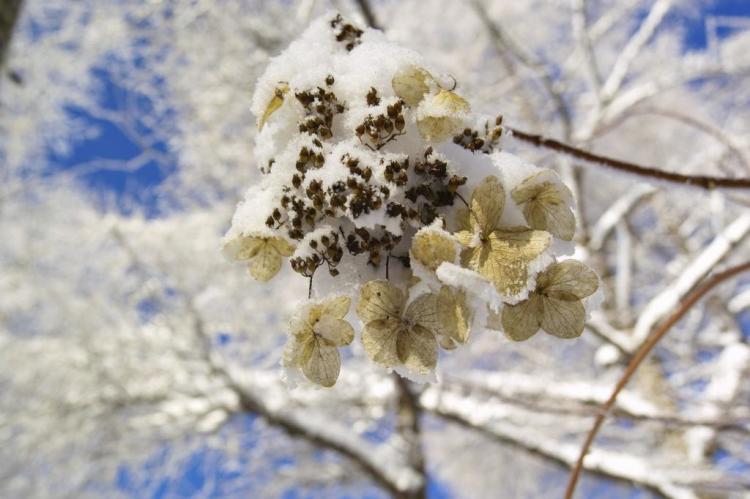
In winter, the cutting must be protected from frost [Photo: KPG Payless2 / Shutterstock.com]
From September the cutting can now be planted in its own pot. It is important that the plant is placed in a frost-free place over the winter. In the spring it can then be transplanted into a larger pot and moved outside in the following year.
Are climbing hydrangeas poisonous?
With hydrangeas it is generally true that they can cause discomfort in animals such as dogs, cats, hamsters or rabbits as well as in humans if consumed. These show up in various symptoms such as dizziness, circulatory problems, anxiety and even shortness of breath. If there is an allergy, even skin contact can lead to a reaction in the body. Therefore, especially small children should be supervised and informed that the beautiful flowers are only used for decoration. However, the flowers and leaves taste so bitter that they are usually neither consumed by animals nor humans in large quantities. You can find more information about the toxicity of hydrangeas here.
Would you like to find out more about the romantic flowering shrubs? Then you will find everything you always wanted to know in our hydrangea article.

